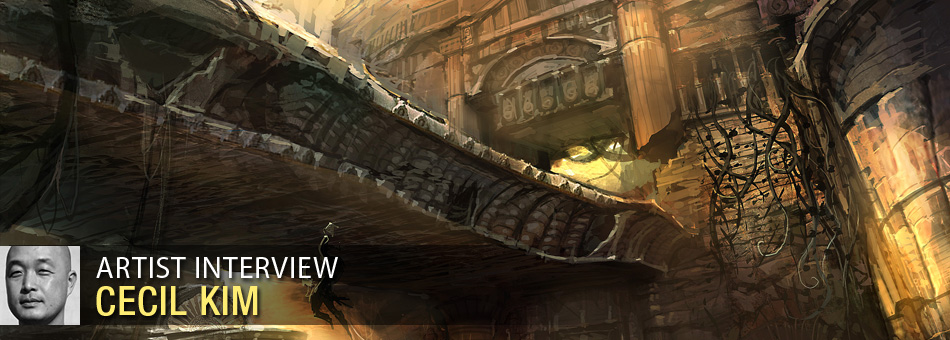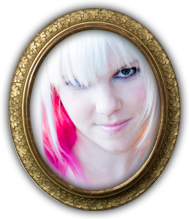Interviews
Cecil Kim Interview
February 23, 2012
A great interview with ST artist Cecil Kim!
Interview by Travis Bourbeau
Cecil, can you please tell us about your job title?
CK: I am a Co-Owner/Creative Director of Section Studios and Bluecanvas, Inc which I joined after 11 years of employment with Sony Santa Monica Studio. I was Visual Development Lead at Sony Santa Monica Studio who brought the God of War franchise and many other hit titles to the gaming world. I also teach at Otis College of Art and Design and Art Center College of Design in the entertainment design program and have taught at Gnomon School of Visual Effects.
What skills should a successful environment designer or concept artist have to succeed in games?
CK: A concept artist needs to stay inspired throughout a long cycle of game production and be able to capture a game director’s vision in concept art. It’s like being a visual communicator who translates the director’s concept into drawings and renderings for the production team to use as a blueprint or guideline. Once the bigger pictures are all drawn out, then a concept artist would collaborate with the animation, level design, combat, cinematic, user interface, and SFX departments to assist their production needs. A single picture is better than a thousand words; everything is easier to communicate with a piece of concept art between a director and production team. It’s a real benefit of working in the game industry as a concept artist–to be able to influence and get involved in many areas of game making.

What do you feel has changed the most in your own work over your last few projects?
CK: My main focus has always been environment concept, but because of so many talented artists I have worked with closely-such as Charlie Wen, Scott Seeto, Ryan Meinerding, Christian Lorenz Scheurer, Andy Park, Dwayne Turner, Izzy Medrano, Jung Park, Martin Mercer, Iain McCaig, Eric Ryan, Danny Gardner, Mark Castanon, Anthony Jones, Cliff Childs, and Luke Berliner, I have learned each artists’ own artistic approaches and work-ethics eventually forcing me to try their own style…and it did show through some of my work recently. I have a pretty strong voice in my work so it’s subtle, however in the past few projects, I became more confident doing other stuff besides environment concept because of them.
How do you go about collecting reference or gaining inspiration for creating new worlds?
CK: Creative directors and art directors often use movies as reference because they have different artistic elements combined effectively, such as sound, music, composition, historical adaptation, architecture, costume, etc. However, within the context of their ideas, there is a lot more information we can use from their written pitch such as literature, popular culture, philosophical or historical analysis, technological influences and so on. So I start by reading their pitch and use all the attributes to define the visual style and details of new worlds. Also it’s important to constantly review the design and see if anything has been already defined by other artists.

Why teach? Are there any personal benefits to sharing your technique?
CK: Teaching is a great way to stay motivated and creatively inspired, especially when you are burned out from your work. Not only do I get to help students, I also get the most updated information and news in the industry from them. Schools like Gnomon also have a good mix of international students with their own social/cultural background that I never knew of. I find it very exciting to be working with those students. Seeing them struggling and slowly stepping into their dream career totally reminds me of myself, and it’s also a good way to remind myself of mistakes and bad decisions I have made in the past so I can advise them into the right direction. Also the energy and pure spirit you see from their work and self is definitely a big reward in teaching. I never think of it as sharing my techniques with my students. They know more about techniques in new CG software anyway. It’s more about how you use those techniques in a team environment and this is what I focus on. Schools are expensive. However, school provides a community and brings artists together. I always want to stay inside art communities whether I am a student or a teacher.

How important is illustration vs. design in creating a strong playable environment experience for the gamer?
CK: They are both extremely important from a production standpoint. If you compare the amount of work you get to finish during the production cycle, production environment concepts far outweigh illustrations. Illustrations are most likely required during early pitch and towards the end of production for marketing purposes. It’s often possible to hire outside contractors or a marketing agency to do those illustrations if the team hasn’t already hired a go-to guy (like Charlie Wen or myself ![]() ), or if the concept department is busy with a production schedule and it’s easier to outsource them from the management’s point of view.
), or if the concept department is busy with a production schedule and it’s easier to outsource them from the management’s point of view.
You need slightly different skill sets to do a marketing illustration, such as stylized rendering technique or being able to finish over 3D game asset renderings. Also, being able to execute interesting compositions with dynamic character action poses to capture the essence of the game. Those are not easy if you haven’t had enough traditional training. You need to have a really well-trained eye to include all the important marks a director wants to put into a single illustration. However, at the beginning of an artist’s career, it’s not easy to be good at everything, unless you are Andy Park or Izzy Medrano. So you always keep this in mind and strive to strengthen your weaknesses, and eventually you will find a good balance.
What is missing from demo reels and portfolios of students seeking work?
CK: It’s ok to have only a few things…really. Many students put up so many different pieces in different categories that do not reflect their strongest area of expertise. It’s not good. Companies will look at your portfolio and try to find what creative services you can offer for their product. They would not need to see your still-life watercolor or personal decoration on your ceramics. What’s missing from most of the portfolios are some early ideation sketches and process artworks for your final artworks, whether it’s a creature design or weapon design.

Any advice for aspiring students or professionals?
CK: Everything takes time, but once you get good at one thing, it will most likely stay with you. I wanted to compare art to some of the sports we enjoy playing–golf or tennis–they all have different learning curves for each one of us. It’s really strange some of the stuff we can do-we don’t even see the improvement and suddenly we become good at it. However it’s all a matter of how hard you practice everyday until you can iron out a good swing…with confidence and consistency.

What is your next step?
CK: Departing from Sony wasn’t an easy decision. I have learned so much about game-making and I am grateful to be a part of Sony Santa Monica Studio. However it’s time for me to go after my dream. A new chapter in my career begins! I am running a new design company called Section Studios. We will be providing services in concept art, art direction, illustration, web design and also developing our own IP. More information will be released soon.
Check out Cecil on Sketch Theatre here
Learn from Cecil and The Gnomon Workshop by picking up his tutorials here







